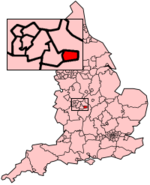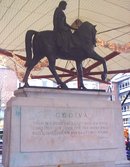Coventry
|
|
- For alternative meanings see: Coventry (disambiguation)
Coventry is a city and metropolitan borough in the West Midlands of England. Coventry is the ninth largest city in England with a population of 304,746 (2002 estimate).
Coventry_city_centre_750.jpg
Coventry has long been a centre of motor and cycle manufacturing, dating back from 1896, the car and cycle industry has been a strong centre point for this town. Starting out with some less familiar names such as Coventry Motette, Great Horseless Carriage Co, Swift and more familiar names like Humber, Riley and Daimler and the Triumph motorcycle having its origins in 1902 in a Coventry factory. Although the motor industry has declined, the Jaguar company has its headquarters and a factory in the city, and a large Peugeot car factory is located in Ryton just outside the city. The famous London black cab taxis are also produced in Coventry by LTI
| City of Coventry | |
|---|---|
 Shown within West Midlands | |
| Geography | |
| Status: | Metropolitan borough, City (1345) |
| Region: | West Midlands |
| Ceremonial County: | West Midlands |
| Area: - Total | Ranked 246th 98.64 km² |
| Admin. HQ: | Coventry |
| ONS code: | 00CQ |
| Demographics | |
| Population: - Total (2003 est.) - Density | Ranked 15th 304,997 3,092 / km² |
| Ethnicity: | 84.0% White 11.3% S.Asian 1.8% Afro-Carib. |
| Politics | |
| Coventry City Council http://www.coventry.gov.uk/ | |
| Leadership: | Leader & Cabinet |
| Executive: | Conservative |
| MPs: | Bob Ainsworth, Jim Cunningham, Geoffrey Robinson |
Coventry's main industries include: cars, electronic equipment, machine tools, agricultural machinery, man-made fibres, aerospace components and telecommunications equipment.
Coventry is becoming increasingly important as a university city, being the home of the University of Warwick and Coventry University. It is also home to the Coventry Transport Museum, where the world speed record breaking cars, Thrust2 and ThrustSSC are displayed.
On the 14th November 1940 during World War II, large areas of the city, including its cathedral, were destroyed in a massive German bombing raid (see History: 20th Century below) and in later raids. The rebuilt Coventry Cathedral was opened in 1962 next to the ruins of the old. It was designed by Basil Spence and contains the tapestry, "Christ in Majesty" by Graham Sutherland and the bronze statue of St Michael and the Devil by Jacob Epstein. Benjamin Britten's War Requiem, regarded by some as his masterpiece, was written for the opening of the new Cathedral.
Coventry's most famous resident was Lady Godiva, who according to legend, probably entirely false, rode through the city naked on horseback (actually, she likely rode the horse bareback, not barenaked), in protest at high taxes being waged on the cityfolk by her husband Leofric. According to the legend, the residents of the city were asked to look away as she rode, but one man didn't and was allegedly struck blind, he became known as Peeping Tom thus originating the term. There is a statue of her in the city centre.
| Contents |
History
- The main article is at History of Coventry, the following is a summary
Coventry_spires.jpg
Coventry is traditionally believed to have been established in the year 1043 with the founding of a Benedictine Abbey by Leofric, Earl of Mercia and his wife Lady Godiva. Current evidence suggests that this abbey was probably in existence by 1022, therefore Leofric and Godiva most likely endowed it around 1043. In time, a market was established at the abbey gates and the settlement expanded.
By the 14th century Coventry had become an important centre of the cloth trade, and throughout the middle ages was one of the largest and most important cities in England. Coventry was granted city status in 1345, and later became a county in its own right.
Hostile attitudes of the cityfolk towards Royalist prisoners held in Coventry during the English Civil War is believed to have originated the phrase "sent to Coventry", which in Britain means 'to be ostracised'.
In the late 19th century Coventry became a major centre of bicycle manufacture, with the industry being pioneered by Rover. By the early 20th century bicycle manufacture had evolved into motor manufacture, and Coventry became a major centre of the British motor industry.
Coventry suffered severe bomb damage during World War II, most notoriously, a massive German air raid on the 14th November 1940, destroyed most of the city centre and Coventry's historic Cathedral.
Coventry_Cathedral_ruins.jpg
In the post war years Coventry was largely re-built, gaining a new pedestrianised shopping precinct and a new much celebrated Cathedral. Throughout the 1950s and 1960s Coventry remained prosperous. However the decline of the British motor industry during the 1970s and 80s hit Coventry hard, in the early 1980s up to 20% of the workforce was unemployed, a hit record about Coventry "Ghost Town" by The Specials summed up the situation in the city. In recent years Coventry has largely recovered with newer industries locating in the city.
On March 1, 2003, Coventry was granted Fairtrade City status.
Famous people
Famous people from Coventry include Frank Whittle the co-inventor of the jet engine, the poet and novelist Philip Larkin, the actors Nigel Hawthorne and Clive Owen, the record producer Pete Waterman, Jason John (also known as Jason Herbert) of the boy group Big Fun, the athelete David Moorcroft and the 2003 Rugby Union World Cup winners Neil Back and Danny Grewcock.
The politician Mo Mowlam grew up in Coventry, and the inventor James Starley lived in the city for most of his life.
Joseph Paxton, the designer of the Crystal Palace, was a Member of Parliament for the city from 1854 to 1865. The current Members of Parliament, following the 2005 General Election, are Geoffrey Robinson, Bob Ainsworth and Jim Cunningham.
Two Tone ska bands The Specials and The Selecter are both from Coventry - one of The Specials' best known hits, Ghost Town was written about the city.
The city's list of more infamous individuals includes porn star Debee Ashby, who achieved notoriety during 1983 when she appeared nude with her mother in an adult magazine.
Arts and culture
- During the early 19th century Coventry was well known to the famous author George Eliot who was born near Nuneaton. The city was the model for her famous novel Middlemarch (1871).
- During the late 1970s and early 1980s, Coventry was the centre of the Two Tone musical phenomenon, with bands such as The Specials coming from the city.
Venues
Theatre, art and music venues in Coventry include:
- The Warwick Arts Centre: situated at the University of Warwick, Warwick Arts Centre comprises an art gallery, a theatre, a concert hall and a cinema. It is the second largest arts centre in the UK, after London's Barbican.
- The Belgrade Theatre: one of the largest producing theatres in Britain, the 866 seat Belgrade was the first civic theatre to be opened in the UK following World War II.
- The Herbert Art Gallery and Museum is a major art gallery in the city.
Sport
Sporting teams include Coventry City (Football), Coventry Rugby Club (Rugby Union), Coventry Blaze (Ice Hockey), Coventry Bears (Rugby League) and Coventry Godiva Harriers (Athletics).coventry bees-speedway
In football, Coventry City won the FA Cup in May of 1987.
Transport
Coventry is near the M6, M69 and M40 motorways. It is also served by the A45 and A46 roads.
For rail, Coventry railway station is served by the West Coast Main Line, and has regular rail services between London and Birmingham (and stations beyond). It is also served by railway lines to Nuneaton via Bedworth. There is a line linking it to Leamington Spa and onwards to the south coast. Bus services in Coventry are operated by Travel West Midlands.
The nearest major airport is Birmingham international Airport, some 10 miles (16km) to the west of the city. Coventry has its own airport, Baginton, which is largely a freight airport. However, since 2004, ThomsonFly have been operating commercial scheduled flights from Baginton to various European destinations.
The Coventry Canal terminates in the city centre.
Local government
Traditionally a part of Warwickshire (although it was a county in its own right for 400 years), Coventry became a county borough in 1889 and later a metropolitan district of the West Midlands county in 1974. The disbanding of the metropolitan council took place in 1986, whereupon it became administered as an effective unitary authority.
Coventry is administered by Coventry City Council. The city is divided up into 18 wards each with three councillors. Coventry has long been a stronghold of the Labour Party, the city council was for years described as a "one party state", but currently the city council is Conservative controlled.
Nearby places
- Nearby towns: Bedworth, Rugby, Solihull, Kenilworth, Leamington Spa, Warwick, Nuneaton.
- Nearby cities: Birmingham, Leicester, Lichfield.
Twin cities
Coventry was the first ever city to 'twin' with another city and hence began the now common worldwide practice of twinning. It started after World War II when Coventry twinned with Dresden as an act of peace and reconcilliation, both cities having been heavily bombed during the war.
Coventry is now twinned with 26 places across the world:
- Arnhem, Netherlands
- Belgrade, Serbia
- Bologna, Italy
- Caen, France
- Cork, Republic of Ireland
- Cornwall, Ontario, Canada
- Coventry, Connecticut, USA
- Coventry, New York, USA
- Coventry, Rhode Island, USA
- Dresden, Germany
- Dunaujvarosd, Hungary
- Galati, Romania
- Granby, Quebec, Canada
- Graz, Austria
- Jinan, China
- Kecskemet, Hungary
- Kiel, Germany
- Kingston, Jamaica
- Lidice, Czech Republic
- Ostrava, Czech Republic
- Parkes, New South Wales, Australia
- Saint-Etienne, France
- Sarajevo, Bosnia Herzegovina
- Volgograd, Russia
- Warsaw, Poland
- Windsor, Canada
External links
- Coventry City council (http://www.coventry.gov.uk/cocoon/index.xml)
- Coventry history website (http://www.historiccoventry.co.uk/)
- Coventry and Warwickshire website (http://www.cwn.org.uk/index.html)
- Local Coventry News in Association with the Coventry Evening Telegraph (http://iccoventry.icnetwork.co.uk/0100news/0100localnews)
| Districts of England - West Midlands | 
|
|
Birmingham | Bridgnorth | Bromsgrove | Cannock Chase | Coventry | Dudley | East Staffordshire | Herefordshire | Lichfield | Malvern Hills | Newcastle-under-Lyme | North Shropshire | North Warwickshire | Nuneaton and Bedworth | Oswestry | Redditch | Rugby | Sandwell | Shrewsbury and Atcham | Solihull | South Shropshire | South Staffordshire | Stafford | Staffordshire Moorlands | Stoke-on-Trent | Stratford-on-Avon | Tamworth | Telford and Wrekin | Walsall | Warwick | Wolverhampton | Worcester | Wychavon | Wyre Forest | |
|
Administrative Counties with multiple districts: Shropshire, Staffordshire, Warwickshire, West Midlands, Worcestershire |
eo:Coventry es:Coventry fr:Coventry nl:Coventry pl:Coventry fi:Coventry sv:Coventry

